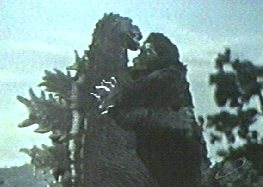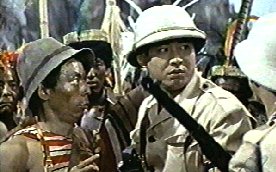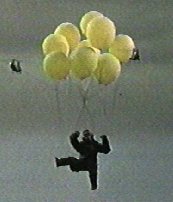King Kong vs Godzilla
  
The plot is simplicity itself: Godzilla is freed from the iceberg he was encased in at the end of Godzilla Raids Again. OK, Godzilla wasn't actually trapped in an iceberg, he was buried by an avalanche of snow on a remote island. OK, it didn't really look like an avalanche of snow, it looked more like a someone dropped a couple of bucketfuls of chipped ice on top of him. Whatever. Godzilla immediately heads for Japan. Why he does this is never really explained -- maybe he likes karaoke bars. Or really hates karaoke bars. When you're dealing with a 150-foot tall monster, the end result is going to be the same, at least until they design a karaoke bar with a 200-foot tall entrance. Meanwhile, the CEO of a pharmaceuticals company sends some of his employees to Faro island to look for a berry they are hoping to process into medicine. The expedition finds the berry and an unexpected bonus: King Kong. The members of the expedition decide to do the only thing any reasonable person would when faced with a 150-foot tall giant ape. That is, they decide to bring it back to Japan. Probably to show off all the karaoke bars they have.* Before long, King Kong and Godzilla are both rampaging around Japan. It isn't all that much longer before they're wrestling their way across Japan. And of course, there's a wacky cast of Japanese character actors to watch helplessly as giant monsters destroy Tokyo once again.
Like Alice's White Queen, true Godzilla fans can believe six impossible things before breakfast, so long as those things involve their favorite giant green lizard. They just keep reminding themselves why they are here: to see the Big G kick some monster butt and destroy a few cities along the way. What can't be cheerfully dismissed, however, is the American butchering of an otherwise enjoyable Godzilla movie. As with the original 1954 Godzilla, Universal Studios thought the Japanese cut of the film to be unsuitable for American audiences. Thus, they cut out certain scenes -- mostly those which develop the personalities of the various characters -- and replaced them with infuriating "U.N. Newscasts," which serve to explain the plot details that have been removed. They also kill the action immediately. When this version is viewed against the original cut, it becomes obvious that American studio executives (and in particular, American producer John Beck) thought American audiences were stupid. What, we can't appreciate the fact that the two women back home are worrying about their explorer boyfriends? We wuz robbed!
Yet another odd feature of this film is the relationship between the two monsters and electricity. We are informed in this movie that Godzilla is afraid of electricity, and he won't cross even modest power lines. Compare this to Godzilla's reaction to the power line defense that was used to protect Tokyo in the original Godzilla. King Kong has also gained some sort of affinity for electricity, and lighting makes him stronger. The reasoning behind this seems to be that King Kong really was sort of a god back on his island. King Kong's ability to manipulate electricity also serves to help even up the odds between the two monsters when they fight, because otherwise Kong has no way to counter Godzilla's atomic ray. Despite its eccentricities, King Kong vs Godzilla (even the U.S. version) is a must-see for those looking to attain the Godzilla experience. It has plenty of giant monster face-off action, a fair amount of humor, a suitably high kitsch-factor, and all the cheap blue-screen effects you can eat. Plus a craaaazy native beat you can dance too, if you're so inclined.
* We do not mean here to suggest that Japan consists of nothing but karaoke bars. According to an article we read in Newsweek, they also have pornographic comic books. Back to the review.
 Review date: 2/12/98 
This review is © copyright 1997 Chris Holland & Scott Hamilton. Blah blah blah. Please don't claim that it's yours blah blah, but feel free to e-mail it to friends, or better yet, send them the URL. To reproduce this review in another form, please contact us at guys@stomptokyo.com. Blah blah blah blah. |


